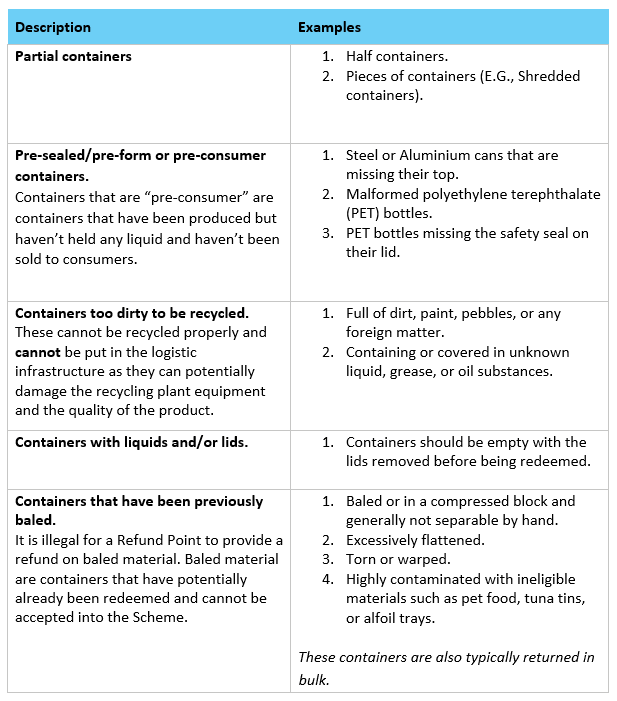Contamination is a common issue in recycling. Whether through ignorance, carelessness, or by practicing “wishful recycling”, the public tends to add to recycling bins material that cannot be recycled due to its nature or state.
In the Containers for Change scheme, the problem is similar, and you can find three main types of issues:
- Containers that are not part of the Scheme. Specifically, containers that are not part of the DWER list of eligible containers.
- Containers that are contaminated. Specifically, containers that are unsuitable for recycling or could potentially pose a health risk to the Refund Point or processing staff.
- Containers sorted in the wrong collection infrastructure. Specifically, container types are mixed.
Containers that are not part of the Scheme
These ineligible containers might be made of the same material as some eligible ones, but they still cannot be put through the Scheme.
Indeed, RPOS are paid for each counted eligible container, and controls are regularly performed to check that only eligible containers have been counted and returned.
If you are audited, you could be in breach of your contract if ineligible containers are found in your logistic infrastructure, even if you have not provided a refund for it. For more information see How to determine container eligibility.
Please note: This also includes rubbish, paper, soft plastics bags, cardboard, and dirt. This material usually belongs in the yellow or rubbish bin.
Contaminated containers
The second type of unacceptable containers are containers that could be eligible, but the condition of the container does not allow them to be accepted.
These containers might be too contaminated for safe recycling, pose a health risk, or cannot be accepted under the government guidelines.
This includes:

Any containers displaying the above characteristics should not be accepted and the attempted return should be reported to your Contract Manager.
Your Contract Manager will pass this information onto the respective area within WARRRL for actioning. RPOs should expect to receive feedback from WARRRL regarding the issue raised. You can also contact our Scheme Integrity team directly by emailing: [email protected]
If you or your staff are unsure about the status of a container that is returned to you, please contact your Contract Manager or [email protected] before accepting it. Doing so could protect your business from possible fraudulent behaviour.
For more details with examples, please see The contamination reference table.
Containers sorted in the wrong collection infrastructure
Sorting controls must be in place to avoid contamination in your logistic infrastructure. Each collection infrastructure needs to be regularly checked, especially before being tipped into a larger infrastructure (such as a skip bin or compactor) no matter if the sorting is manual or automatic.
Regular inspections are required to be undertaken by staff of logistic infrastructure to check for ineligibles, wrongly sorted containers, and containers with lids. All these scenarios constitute an issue either in terms of recycling, safety, or scheme integrity.
It is the responsibility of the RPO to ensure each bin is free from contamination before being picked up by the logistic providers.
Scheduled and unannounced checks are undertaken at Refund Points to ensure the quality is consistent.
Good practice to deal with ineligibles and contamination
At depots
For over-the-counter transactions, it is best practice to give back non-accepted materials to the customer so they can dispose it.
If you choose to accept and dispose of them, those cannot be put into the collection infrastructure but must be recycled via a different stream.
At bag drops
Make sure that you count and enter ineligible containers in your POS system. You should also use the Bag drop issue function to inform the customers of any contamination such as lids on bottles.
The customer will be notified of it in their email receipt. This will also assist the Help Desk dealing with customers who may call regarding a missing payment.
For more information see “Dealing with contamination at bag drops”